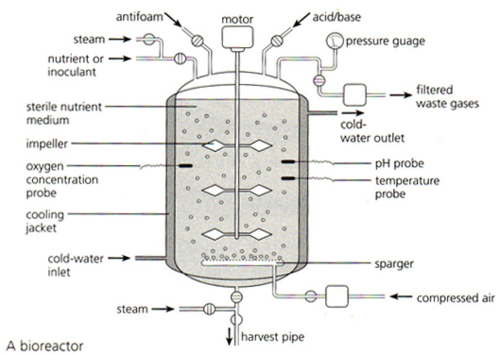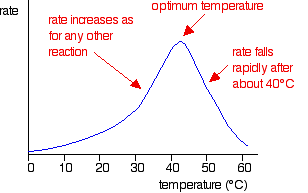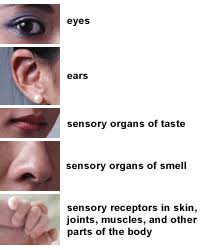5.9 explain the methods which are used to farm large numbers of fish to provide a source of protein, including maintenance of water quality, control of intra-specific and inter-specific predation, control of disease, removal of waste products, quality and frequency of feeding and the use of selective breeding.
Why fish are attractive to farmers:
1. Low fat, High protein
2. Efficient at turning nutrients into fish mass
Advantages:
They can control quality of the water (clean)
They can control predators
They can reduce pests and disease
This contributes to an increase in yield of fish.
High density of fish could cause high transmition in disease
Some farmers use antibiotics because of this (bad for human health)
Pesticides are also a cause of concern
Monday, February 20, 2012
5.8 Fermenter
5.8 interpret and label a diagram of an industrial fermenter and explain the need to provide suitable conditions in the fermenter, including aseptic precautions, nutrients, optimum temperature and pH, oxygenation and agitation, for growth of microorganisms.
Fermenter: the reaction vessel where fermentation occurs. The aim is to have optimum growth conditions for fermentation to occur.

Fermenters are used to give the reaction optimum conditions
Fermenter: the reaction vessel where fermentation occurs. The aim is to have optimum growth conditions for fermentation to occur.

Fermenters are used to give the reaction optimum conditions
5.7 Yogurt
5.7 Understand the role of bacteria (Lactobacillus) in the production of yogurt.
1. Cow produces milk
2. Milk treated to remove pathogens (e.g. TB). This is called pasteurization.
3. The milk sugars are converted into lactic acid (By incubating the milk at 45-46C and to add the lactobacillus)
4. Acid will result in a lower PH and causes milk proteins.
5. Milk proteins will solidify (yogurt).
1. Cow produces milk
2. Milk treated to remove pathogens (e.g. TB). This is called pasteurization.
3. The milk sugars are converted into lactic acid (By incubating the milk at 45-46C and to add the lactobacillus)
4. Acid will result in a lower PH and causes milk proteins.
5. Milk proteins will solidify (yogurt).
5.5 Beer production
5.5 Understand the role of yeast in the production of beer
Beer is largely Ethanol. This is produced from glucose which is broken down to ethanol and carbon dioxide.
Yeast + Enzymes
glucose ------------------------> ethanol + Carbon dioxide
Ethanol is flavored by the addition of plants.
amylase maltase
Starch ---------------> Moltose --------------------> Glucose
Starch comes from things such as barley seeds, wheat seed, and even rice.
This happens through the process called malting

Beer is largely Ethanol. This is produced from glucose which is broken down to ethanol and carbon dioxide.
Yeast + Enzymes
glucose ------------------------> ethanol + Carbon dioxide
Ethanol is flavored by the addition of plants.
amylase maltase
Starch ---------------> Moltose --------------------> Glucose
Starch comes from things such as barley seeds, wheat seed, and even rice.
This happens through the process called malting

5.4 Pesticides and biological control
5.4 understand the reasons for pest control and the advantages and disadvantages of using pesticides and biological control with crop plants.
a) Pesticides
Monocultrue: Where there are large fields of crops all of the same type
Monoculture --------> Pests crop food sources
This reduces productivity of farming. Loss of food and money.
Pesticides are chemicals which re designed to kill pests.
Advantages:
Chemicals are easy to obtain
They are easy to apply
3. Very effective
Disadvantage:
1. Toxic (will kill other plants and animals and harmful to humans)
2. Bio-accumulation (the pesticide builds up through the food chain cause problems for other animals)
3. Mutation in the pest often leads to resistance, meaning the concentration has to be constantly added till it no longer works and needs to be replaced.
B) Biological control
a) Pesticides
Monocultrue: Where there are large fields of crops all of the same type
Monoculture --------> Pests crop food sources
This reduces productivity of farming. Loss of food and money.
Pesticides are chemicals which re designed to kill pests.
Advantages:
Chemicals are easy to obtain
They are easy to apply
3. Very effective
Disadvantage:
1. Toxic (will kill other plants and animals and harmful to humans)
2. Bio-accumulation (the pesticide builds up through the food chain cause problems for other animals)
3. Mutation in the pest often leads to resistance, meaning the concentration has to be constantly added till it no longer works and needs to be replaced.
B) Biological control
Biological control is a way of reducing the population of a pest without using pesticides.
Another alien species has to be brought in that is higher in the food chain, to reduce the numbers of the population of the plant or animal
Advantages
1. Not toxic
2. Smaller impact on life
Disadvantages
1. Doesn't always work
2. Hard to control
3. The alien species could become unwanted
5.3 Fertilizers
5.3 understand the use of fertilizers to increase crop yield.
Fertilizers are usually Nitrates, phosphates or a combination of both.
These compounds are applied to the soil, they go down in the soil and are taken up by the plants root structure, and then moved in the transpiration stream up to the leaf and used in the leaf for the construction of proteins (nitrates) and phosphates (DNA and membrane structure).
Fertilizers can be divided into two groups:
1.Organic: produced from animal waste on farms, then collected by the farmer (usually after decomposition and fermentation) and forms a compound known as slurry which is applied to the fields, giving the plant a supply of nitrate and phosphate to promote growth.

2. Artificial: Chemical which are synthetically produced e.g. potassium nitrate and amonium nitrate, bought by the farmer and applied to the field which will go into a solution which will release the nitrates and phosphates which promotes growth.

Possibly causes Eutrophication which is a problem which arises from fertilizers.
Fertilizers are usually Nitrates, phosphates or a combination of both.
These compounds are applied to the soil, they go down in the soil and are taken up by the plants root structure, and then moved in the transpiration stream up to the leaf and used in the leaf for the construction of proteins (nitrates) and phosphates (DNA and membrane structure).
Fertilizers can be divided into two groups:
1.Organic: produced from animal waste on farms, then collected by the farmer (usually after decomposition and fermentation) and forms a compound known as slurry which is applied to the fields, giving the plant a supply of nitrate and phosphate to promote growth.
2. Artificial: Chemical which are synthetically produced e.g. potassium nitrate and amonium nitrate, bought by the farmer and applied to the field which will go into a solution which will release the nitrates and phosphates which promotes growth.

Possibly causes Eutrophication which is a problem which arises from fertilizers.
5.2 Crop Yield
5.2 understand the effects on crop yield of increased carbon dioxide and increased temperatures in glasshouses.
light+enzymes
Remember: photosynthesis= Carbon dioxide + water ---------------> Glucose + oxygen
Increasing the concentration of Co2 -------> Substrate
Increasing Co2:

Increasing temperature:

Increasing temperature also avoids frost damage and provides constant temperatures.
light+enzymes
Remember: photosynthesis= Carbon dioxide + water ---------------> Glucose + oxygen
Increasing the concentration of Co2 -------> Substrate
Increasing Co2:

Increasing temperature:

Increasing temperature also avoids frost damage and provides constant temperatures.
5.1 Glasshouses
5.1 describe how glasshouses and polythene tunnels can be used to increase the yield of certain crops.
Glasshouses are simple house structure's but all surfaces are glass so that light can penetrate through to the interior.

How glasshouses work:
1. Solar radiation - initial source of energy in the form of light.
2. Light is able to penetrate through the glass to the internal surfaces
3. Light is absorbed by surfaces inside the glass house e.g. the soil, the plants.
4. The surfaces will re emit the energy as heat.
5. the heat, warms the air and rises it's average kinetic energy and the temperature increases.
6. The warm air is trapped, it cools at the upper surfaces and sink to the floor to be rewarmed.

How does this affect crop yield?
warm air in glasshouse -----------> increase in crop yield
1. This has to do with the relation between temperature and the rate of reaction.
The higher temperatures in the glass house are closer to the optimum temperature for enzyme reactions inclusing Photosynthesis.
2. Also, it provides constant temperatures and so constant productions.
3. Prevention of loss of water vapor
4. Avoids frost damage, particularly to seedlings.
5. Glasshouses are often warmed by the burning of fossil fuels:
a) increase in the carbon dioxide levels in glasshouse. Increase concentration of the substrate for photosynthesis which mean more product and growth.
b) Ethene ------> stimulates fruit ripening.
Glasshouses are simple house structure's but all surfaces are glass so that light can penetrate through to the interior.

How glasshouses work:
1. Solar radiation - initial source of energy in the form of light.
2. Light is able to penetrate through the glass to the internal surfaces
3. Light is absorbed by surfaces inside the glass house e.g. the soil, the plants.
4. The surfaces will re emit the energy as heat.
5. the heat, warms the air and rises it's average kinetic energy and the temperature increases.
6. The warm air is trapped, it cools at the upper surfaces and sink to the floor to be rewarmed.

How does this affect crop yield?
warm air in glasshouse -----------> increase in crop yield
1. This has to do with the relation between temperature and the rate of reaction.
The higher temperatures in the glass house are closer to the optimum temperature for enzyme reactions inclusing Photosynthesis.
2. Also, it provides constant temperatures and so constant productions.
3. Prevention of loss of water vapor
4. Avoids frost damage, particularly to seedlings.
5. Glasshouses are often warmed by the burning of fossil fuels:
a) increase in the carbon dioxide levels in glasshouse. Increase concentration of the substrate for photosynthesis which mean more product and growth.
b) Ethene ------> stimulates fruit ripening.
Monday, January 30, 2012
2.85 describe the structure and functioning of a simple reflex arc illustrated by the withdrawalof a finger from a hot object

Only the spinal chord is used to product a reflex. This is so that time is reduced for the response and the persons finger won't be damaged as much.
Reflexes are always the same.
Reflexes can't be controlled but responses can.
The receptors are stimulated by the heat, electrical impulses sent to the spinal chord, The relay nerve directly connects the impulses to the motor nerve which creates the response to withdraw the hand.
2.84 understand that stimulation of receptors in the sense organs sends electrical impulses along nerves into and out of the central nervous system, resulting in rapid responses
- The receptors in the sense organs, when stimulated create electric impulses along the nerves.
- This moves into the nervous system and out to create a rapid response.
e.g. Light enters the eyes, this creates an electrical impulse along the nerves. They move in and out of the nervous system, to the effector and create a response such as blinking.

- This moves into the nervous system and out to create a rapid response.
e.g. Light enters the eyes, this creates an electrical impulse along the nerves. They move in and out of the nervous system, to the effector and create a response such as blinking.
2.83 recall that the central nervous system consists of the brain and spinal cord and is linked to sense organs by nerves
-The Central nervous system consists of the brain and the spinal chord.
-Receptors send electrical signals to the effectors using the nerves.

-Receptors send electrical signals to the effectors using the nerves.

2.82 describe how responses can be controlled by nervous or by hormonal communication and understand the differences between the two systems
Differences:
-Hormones act slower and have a longer effect
-Hormones are transported via the blood stream and bind to receptors on the outside of cells
-Hormone molecules can cause chain reactions
-Nerves communicate through electrical impulses
-They both use they same transmitters, but use them in different way.
-Hormones act slower and have a longer effect
-Hormones are transported via the blood stream and bind to receptors on the outside of cells
-Hormone molecules can cause chain reactions
-Nerves communicate through electrical impulses
-They both use they same transmitters, but use them in different way.
Monday, January 16, 2012
Thermoregulation
2.77 Understand that homeostasis is the maintenance of a constant internal environment and that body water content and body temperature are both examples of homeostasis.
Homeo is the idea of something being the 'same'.
Stasis refers to the idea of a fixed point or a set of conditions.
Homeostasis is the idea that the conditions are kept the same or constant.
Homeothermic is the idea of maintaining the same temperature.
Some organisms (e.g. mammals) which when the environmental temperature increases or decreases, their body temperature stays constant. These are homeothermic organisms.
The carry a process called thermoregulation, an example of homeostasis.
Mammals need to maintain a constant body temperature because of rates of reactions and to prevent denaturing (enzymes).
The optimum temperature for the enzymes, tends to be the temperature that the mammals maintain their body at.
Homeo is the idea of something being the 'same'.
Stasis refers to the idea of a fixed point or a set of conditions.
Homeostasis is the idea that the conditions are kept the same or constant.
Homeothermic is the idea of maintaining the same temperature.
Some organisms (e.g. mammals) which when the environmental temperature increases or decreases, their body temperature stays constant. These are homeothermic organisms.
The carry a process called thermoregulation, an example of homeostasis.
Mammals need to maintain a constant body temperature because of rates of reactions and to prevent denaturing (enzymes).
The optimum temperature for the enzymes, tends to be the temperature that the mammals maintain their body at.
Subscribe to:
Posts (Atom)
